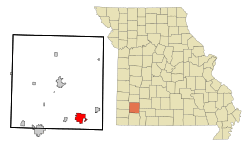Aurora, Missouri facts for kids
Quick facts for kids
Aurora, Missouri
|
|
|---|---|

Location of Aurora, Missouri
|
|
| Country | United States |
| State | Missouri |
| County | Lawrence |
| Founded | 1870 |
| Incorporated | 1885 |
| Government | |
| • Type | Council - Manager |
| Area | |
| • Total | 6.33 sq mi (16.39 km2) |
| • Land | 6.30 sq mi (16.31 km2) |
| • Water | 0.03 sq mi (0.08 km2) |
| Elevation | 1,401 ft (427 m) |
| Population
(2020)
|
|
| • Total | 7,219 |
| • Estimate
(2023)
|
7,512 |
| • Density | 1,146.42/sq mi (442.64/km2) |
| Time zone | UTC-6 (Central (CST)) |
| • Summer (DST) | UTC-5 (CDT) |
| ZIP code |
65605
|
| Area code(s) | 417 |
| FIPS code | 29-02548 |
| GNIS feature ID | 0713486 |
| Website | aurora-cityhall.org |
Aurora is a city located in Lawrence County, Missouri, in the United States. In 2020, about 7,219 people lived in the city.
Contents
History of Aurora
The area around Honey Creek, close to Aurora, was first settled by pioneers from Tennessee. These early settlers included James D. Hillhouse and Reverend A. A. Young. Their families later helped to establish Aurora. Famous descendants include actor Brad Pitt and writer Raelynn Hillhouse.
Aurora was officially planned out in 1870 by Stephen G. Elliott. It is believed to be named after Aurora, the Roman goddess of dawn.
Mining in Aurora
In 1885, a valuable mineral called Galena (which contains lead) was found while digging a well. This discovery started Aurora's journey as a mining town. Mining began on the surface in 1886. Soon after, larger mining operations started as miners dug deeper. They found both zinc and galena. The zinc from Aurora's mines was known for being very pure and high quality. By 1893, over 12,651 tons of zinc ore had been shipped from Aurora. The mines attracted many prospectors and miners. Around 1900, Aurora's population grew to about 10,000 people.
Railroads and Newspapers
In the past, the Frisco Railroad (now Burlington Northern-Santa Fe) and the Missouri Pacific (now Missouri and Northern Arkansas Railroad) had train stations in Aurora. The main office for the Missouri Pacific Railroad's White River division was in Aurora until the mid-1950s.
From 1911 to 1920, a newspaper called The Menace was published in Aurora. It was known for its strong opinions. By 1914, it was read by over one million people across the country.
The Lewis Shaw Coleman House is a historic building in Aurora. It was added to the National Register of Historic Places in 2016.
Geography of Aurora
Aurora is located at 36°58′12″N 93°43′14″W / 36.97000°N 93.72056°W. According to the United States Census Bureau, the city covers a total area of about 5.98 square miles (15.49 square kilometers). Most of this area, about 5.95 square miles (15.41 square kilometers), is land. Only a small part, about 0.03 square miles (0.08 square kilometers), is water.
Population Information
| Historical population | |||
|---|---|---|---|
| Census | Pop. | %± | |
| 1890 | 3,482 | — | |
| 1900 | 6,191 | 77.8% | |
| 1910 | 4,148 | −33.0% | |
| 1920 | 3,575 | −13.8% | |
| 1930 | 3,875 | 8.4% | |
| 1940 | 4,056 | 4.7% | |
| 1950 | 4,153 | 2.4% | |
| 1960 | 4,683 | 12.8% | |
| 1970 | 5,359 | 14.4% | |
| 1980 | 6,437 | 20.1% | |
| 1990 | 6,459 | 0.3% | |
| 2000 | 7,014 | 8.6% | |
| 2010 | 7,508 | 7.0% | |
| 2020 | 7,219 | −3.8% | |
| U.S. Decennial Census 2013 Estimate |
|||
2010 Census Details
In 2010, the census showed that 7,508 people lived in Aurora. There were 2,948 households and 1,943 families. The population density was about 1,261.8 people per square mile (487.2 people per square kilometer). There were 3,396 housing units in the city.
Most of the people in Aurora were White (92.3%). Other groups included African American (0.3%), Native American (0.9%), and Asian (0.2%). About 7.5% of the population was Hispanic or Latino.
About 36.1% of households had children under 18 living with them. About 46.8% were married couples. The average household had 2.52 people, and the average family had 3.09 people.
The average age in the city was 35.8 years. About 27.6% of residents were under 18. About 15.8% were 65 years or older. The population was 47.2% male and 52.8% female.
Transportation in Aurora
The Jerry Sumners Sr. Aurora Municipal Airport is located about 2 miles (3.2 kilometers) southeast of Aurora's main business area.
Education in Aurora
The Aurora R-VIII School District manages several schools. These include an early childhood school, a middle school, a junior high school, and Aurora High School.
Aurora also has a public library. It is a part of the Barry-Lawrence Regional Library system.
Media in Aurora
The local newspaper for Aurora is called The Aurora Advertiser.
Notable People from Aurora
- Arthur "Doc" Barker, a figure from the past; born in Aurora.
- Fred Barker, a figure from the past; born in Aurora.
- Don S. Davis, an actor known for roles in Twin Peaks and Stargate SG-1.
- Raelynn Hillhouse, a national security analyst and novelist.
- Isaac V. McPherson, a congressman from Missouri.
- Harvey Phillips, a famous tuba player known as Mr. Tuba.
- Lefty Williams, a pitcher for the 1917 World Series champion Chicago White Sox.
- Johnny Lee Wilson, a person who was wrongly accused and later found innocent.
See also
 In Spanish: Aurora (Misuri) para niños
In Spanish: Aurora (Misuri) para niños

